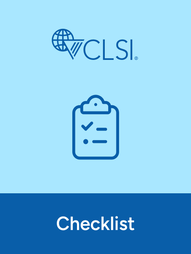
CLSI GP05CL
Waste Management Program – Audit Checklist
Checklist that includes the elements of a waste management program. Formatted on a durable, waterproof sheet for quick reference in the laboratory. Based on CLSI GP05-A3—Clinical Laboratory Waste Management; Approved Guideline—Third Edition, it was written for use by laboratory managers and is intended to provide approaches to controlling laboratory-generated hazardous and nonhazardous waste.
{{FormatPrice(currentPrice)}}
Free
{{FormatPrice(nonMemberPrice)}} List PriceClinical and Laboratory Standards Institute document GP05-A3—Clinical Laboratory Waste Management; Approved Guideline—Third Edition was written for use by laboratory managers and is intended to provide approaches to controlling laboratory-generated hazardous and nonhazardous waste. A brief summary of the relevant US federal regulations and laws is included. The types of waste addressed include chemical, infectious, radioactive, sharps, multihazardous, and nonhazardous. In this edition, emphasis is placed on methods for avoiding waste generation (source reduction), and reducing the volume and toxicity of unavoidable wastes (waste minimization). Options for handling, packaging, labeling, storing, recycling, transporting, treating, and disposing of each type of waste are also described. Although this document will serve as a useful resource for a wider audience, it is based on US regulations and is intended for use primarily in the United States.
Clinical and Laboratory Standards Institute document GP05-A3—Clinical Laboratory Waste Management; Approved Guideline—Third Edition was written for use by laboratory managers and is intended to provide approaches to controlling laboratory-generated hazardous and nonhazardous waste. A brief summary of the relevant US federal regulations and laws is included. The types of waste addressed include chemical, infectious, radioactive, sharps, multihazardous, and nonhazardous. In this edition, emphasis is placed on methods for avoiding waste generation (source reduction), and reducing the volume and toxicity of unavoidable wastes (waste minimization). Options for handling, packaging, labeling, storing, recycling, transporting, treating, and disposing of each type of waste are also described. Although this document will serve as a useful resource for a wider audience, it is based on US regulations and is intended for use primarily in the United States.